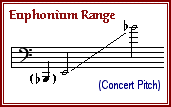
The euphonium is a small version of the tuba, usually constructed in an upright pattern. Most modern euphoniums are constructed with four valves of the piston type, although three-valve models are also seen. The instrument has a large, strongly conical bore, making the sound of the instrument dark and rich. The range is similar to that of the baritone and the tenor trombone, although the lower registers are generally better in quality than on instruments with a smaller bore.
The tone color of the euphonium is the mellowest in the brass band (with the possible exception of the flügelhorn). Despite the large size, it is an agile instrument, and has an extended range when played by a skilled musician.

Role in the Brass Band
The euphonium is the principle tenor voice of the brass band. Its role is similar to that of the cello in a symphony orchestra. The sound is more powerful than that of the baritone, although it can be overwhelmed by the bright choir of trombones and cornets. A full-sized brass band has two euphoniums, and the part is frequently written in divisi. In Salvation Army music, the euphonium is often assigned the counter-melody in contrast to the melody in the cornets.
The euphonium is frequently used as a solo instrument, with solos being more common than for any of the other brass band instruments except for the cornet.
